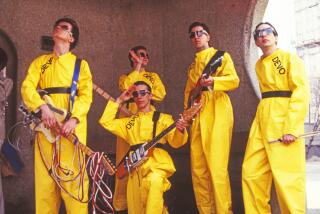Review: Coldplay’s ‘Viva La Vida or Death and All His Friends’
Coldplay “Viva la Vida or Death and All His Friends”Capitol
*** (three stars)
Have you ever picked up a self-help book from the display table in a big-box bookstore and opened it to find a phrase that exactly applied to your life? The most pedestrian insight can sometimes hit surprisingly hard.
Banality might not elevate the intellect, but it helps in a tired, over-wired culture. We’re all so distracted that we need to be reminded of the obvious, again and again. This helps explain the popularity of Coldplay, a group that disgusts sophisticates, although (or because) 10 million or so people seem to prefer its music to Radiohead’s.
Artsy aspirations intensify the aha moments offered by Coldplay’s chief deep thinker, Chris Martin, and his band -- never more so than on its fourth studio album and official leap toward greatness.
I want to believe that “Viva Et Cetera” is Brian Eno’s little trick on Coldplay. The well-meaning rockers wanted to improve their game, so they brought in the producer who’s given growth hormones to David Byrne and U2 as well as Microsoft. (Did you know that Eno designed the startup sound for Windows 95?)
Eno let the lovely Londoners believe they were making classic art-rock when, in fact, his intention was to make shiny new product. Product as art, that is: Eno’s always muddied the distinction between the two, wearing the mask of a “non-musician” to better avoid traditionalist traps and coining the term “ambient” to refer to music that has effect even while you’re ignoring it.
That kind of music, which shares many qualities with Coldplay’s current offering, also has been called “mood” or “background” or even “advertising jingle.” But Eno, who values the effect of creative work over its makers’ original intent, wouldn’t go for such prejudicial terms. The sleekly nonspecific quality of “La Vida” -- it’s full of evocations without settling on any one reference point -- lends power to Martin’s lyrics, making them seem more like common wisdom than clichés.
You can just see Coldplay and Eno in the studio, the musicians happily borrowing ideas from avant-popsters like My Bloody Valentine and Arcade Fire, and Eno, smiling, making it all sound like what you hear in a really great car commercial.
The album starts with an instrumental (Martin, possibly joking, told MTV.com that the band meant to “do a great ring tone”), and when Martin’s words do come, they’re beefed up or buried within extremely canny arrangements that nod toward electronica, Latin and Celtic folk traditions, and the edge of modern classical music that intersects with film scoring.
Coldplay made its fortune on Martin’s hypnotic roundelays, songs that bore simple titles like “Clocks” and “Fix You” and invoked comforting styles like the hymn and the lullaby. Eno pushes the band toward other forms based in circularity -- the ambient music of the marketplace, the video game and the movie trailer -- to make those warm little tunes even more marketable. Are they more memorable too? That depends on whether you like your chicken soup mild or spicy.
-- Ann Powers
More to Read
The biggest entertainment stories
Get our big stories about Hollywood, film, television, music, arts, culture and more right in your inbox as soon as they publish.
You may occasionally receive promotional content from the Los Angeles Times.










